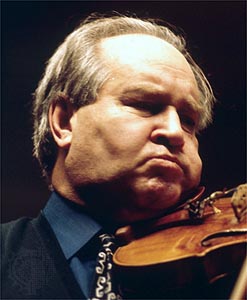
Estonia's David Oistrakh Festival Opens with Violins and Giants
Pärnu, Estonia. The 2008 David Oistrakh Festival in Pärnu, Estonia opened July 18 with violins and Kalevipoeg, both in tribute to the festival namesake, Russian violinist David Oistrakh.

Oistrakh, who summered in Pärnu until his death in 1970 and founded the forerunner of today's Oistrakh Festival, was a giant whose stature was fittingly commemorated, not only by music for violin, but by Estonian composer Eugen Kapp's 1947 ballet suite "Kalevipoeg" about the mythical giant who became the subject of Estonia's epic poem, penned by Friedrich Reinhold Kreuzwald in the mid-19th century.
("Kalevipoeg," meaning “son of Kalev," appears in monumental statuary, on chocolate wrappers and in numerous other forms in this tiny country on the Baltic, where Kreutzwald's epic played an important role in Estonia’s National Awakening in the late 1900s after 700 years of foreign domination.)
The concert, by the Estonian National Youth Symphony Orchestra with guest artists, violinists Viktor Tretjakov and Natalia Lihhopoi, led off a two-week tribute to Oistrakh on the centennial of his birth. A festive crowd gathered in the city’s sparkling new seashell-inspired Concert Hall on the Pärnu River where it empties into the Baltic Sea.
On the podium, banked by blue and white flowers, symbolic of Estonia’s blue, white and black flag, was native son Neeme Järvi, himself a giant in the world of music, his trademark blue handkerchief peeking from the pocket of his white jacket.
A suite from the 1947 ballet “Kalevipoeg” by Estonian composer Eugen Kapp (1908-96) opened the concert on an engaging note. Tretjakov and Lihhopoi were soloists in Bach’s Concerto for Two Violins in D Minor (programmed, said Järvi, because of the Kapp family’s German connections). Tretjakov, one of today’s pre-eminent violinists, topped the evening with a masterful performance of the Brahms Concerto.
The ballet suite, parts of which were first recorded in 1962 by Järvi’s older brother Vallo (1923-94), comprises six episodes from the Faust-like Kalevipoeg’s life. They include: “Kalevipoeg’s Dance with the Maiden of the Lake,” “Finnish Dance,” “Forging of the Swords,” “Dance of the Shepherds and Shepherdesses,” “Dance of the Wind” and Folk Dance. Charming and accessible, each made a vivid impression. Especially picturesque was “Dance of the Wind,” with its fluttery flutes, buzzing cymbals and gale-like fortissimo conclusion.
Following the Kapp, Bach was a kind of dip into pure music. Trejakov and Lihhopoi traversed it with grace and a refined, lace work style filled with gentle warmth and good humor. Järvi led with unerring rhythmic and harmonic focus.
Winner of the 1966 Tchaikovsky International Competition, Tretjakov is not as well known in the West as he should be. The intensity and emotion he poured into the Brahms Concerto were overwhelming, as was his technical mastery. Heli Ernits, principal oboist of the Estonian National Youth Orchestra, opened the Adagio with a splendid, silken-toned solo, while Trejakov’s sweetly expressive tone, soaring into the violin’s highest register, was like an outpouring of birdsong at the end. Despite persistent, rhythmic clapping and repeated bows, he nevertheless withheld an encore.
Note: Tiny Estonia has toasted Oistrakh royally during his centennial year. Where has his native Russia been?